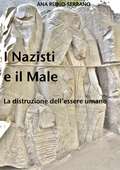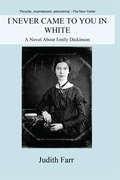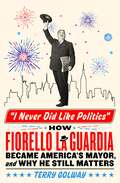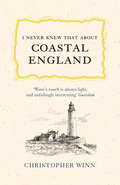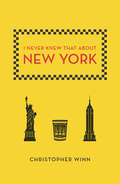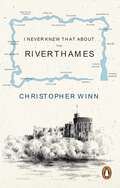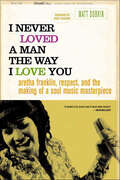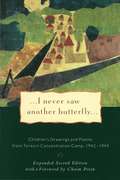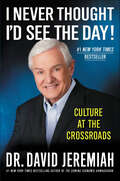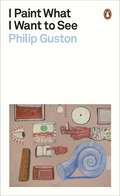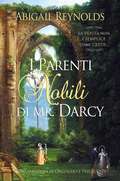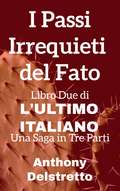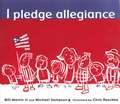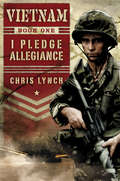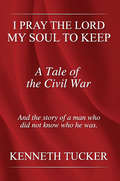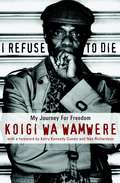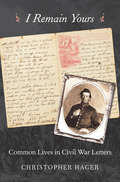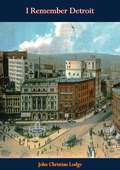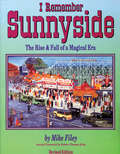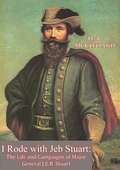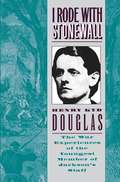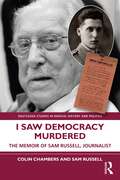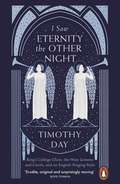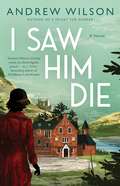- Table View
- List View
I Nazisti e il Male. La distruzione dell'essere umano
by Daniela Giovannetti Ana Rubio-SerranoIl nazismo spalancò le porte al terrorismo globalizzato. Ideò un male strutturale dove nessuno era in salvo neanche il popolo tedesco. Il nemico: tutti coloro che pensavano con una loro testa in maniera libera e diversa rispetto a coloro che dettavano le regole naziste. Gli ariani erano solo "individui fabbricati", ideati per la violenza, ossia automi intelligenti disumanizzati. La socializzazione del crimine attraverso la violenza diventata cultura fu uno degli obiettivi raggiunti sia nei campi di concentramento che nella società. Un libro che mette in luce questioni ancora oggi attuali più che mai.
I Never Came to You in White
by Judith FarrIn 1847 Edward Dickinson's daughter Emily was seventeen, a student at Mary Lyon's female seminary (now Mount Holyoke College) in South Hadley, Massachusetts. Thrilled by the challenges of her education, yet repressed by the school atmosphere, she began writing letters home and to the friends she felt lonely for----passionate letters that reveled in bubbling and irreverent mischief and declared the affectionate intensity of the budding poet. Later, after her death at the age of fifty-five, friends and relatives exchanged misunderstandings of the woman they had known----and of the poetic treasure that they had no sure way of evaluating.Out of these sixty-six imagined letters, Judith Farr, herself a poet and Dickinson scholar, has created a brilliant novel, which, written in the language of Emily Dickinson's contemporaries, lays out the entire emotional spectrum of her life. We see the young Emily groping toward poetic expression. We share the bewilderment of her teachers and friends as the girl reacts with the ingenuity of genius to people, books, and events. We marvel at her private letters "To a Mysterious Person." We smile with her at the confusion of others as they struggle to keep up with the poet's imagination, at those who try to "correct" her mode of expression. We share the experience of the first man to take her photograph. We watch her die, dreadfully and prematurely. When we are done, we have shared in a wondrous mystery, for we are the only ones allowed to know who Emily Dickinson was: these letters are written to us.As Diane Wood Middlebrook has written, "This work of fiction---meticulously researched, delicately attuned to the language of the times---provides an explanation more persuasive than any biography ever will, of what happened to the girl on the brink of womanhood to make her the person who wrote those poems. A startling good read.""Peculiar, incandescent, astonishing"-The New Yorker
I Never Did Like Politics: How Fiorello La Guardia Became America's Mayor, and Why He Still Matters
by Terry Golway"In our current dismal passage of American politics, it’s exhilarating to read about a politician who exemplified all the qualities—courage, honesty, vision, energy, disdain for hypocrisy, concern for the downtrodden—that we were taught to revere....Remarkable." —Wall Street JournalFiorello LaGuardia was one of the twentieth century’s most colorful politicians—on the New York and national stage. He was also quintessentially American: the son of Italian immigrants, who rose in society through sheer will and chutzpah. Almost one hundred years later, America is once again grappling with issues that would have been familiar to the Little Flower, as he was affectionately known. It’s time to bring back LaGuardia, argues historian and journalist Terry Golway, to remind us all what an effective municipal officer (as he preferred to call himself) can achieve...Golway examines LaGuardia’s extraordinary career through four essential qualities: As a patriot, a dissenter, a leader, and a statesman. He needed them all when he stood against the nativism, religious and racial bigotry, and reactionary economic policies of the 1920s, and again when he faced the realities of Depression-era New York and the rise of fascism at home and abroad in the 1930s. Just before World War II, the Roosevelt administration formally apologized to the Nazis when LaGuardia referred to Hitler as a “brown-shirted fanatic.”There was nobody quite like Fiorello LaGuardia. In this immensely readable book, as entertaining as the man himself, Terry Golway captures the enduring appeal of one of America’s greatest leaders.
I Never Knew That About Coastal England
by Christopher WinnWe all love to be beside the seaside! Be it the crunch of the sand beneath your feet, or the promise of an unexplored rock pool that draws you to the sea, prepare to be whisked away by bestselling author Christopher Winn as you delve into the charming tales of England's coastline. Divided into eighteen chapters – one for each of the coastal counties in the UK – this book will entertain and illuminate, by casting new light on the many points of intrigue to be explored along 3000 miles of spectacularly diverse and historically rich English coast. Illustrated with beautiful black-and-white line drawings, by Mai Osawa, this book makes the perfect companion for any seaside outing. You’ll find yourself exclaiming again and again – I never knew that!
I Never Knew That About New York
by Christopher WinnA treasure trove of fascinating trivia about the city that never sleeps Did you know: Grand Central Terminal is the largest railway station in the world. Columbus Circle is the point from which all official distances to and from New York are measured When Queen Elizabeth II visited Trinity Church in 1976, she was presented with 279 peppercorns in back rent Macy’s owns almost a full city block...but not the real estate its famous sign featuring its signature red bag is on. Take a delightful journey from the bottom of the island of Manhattan to the top and discover extraordinary facts about New York along the way. You’ll find yourself saying, "I never knew that about New York!” .
I Never Knew That About the River Thames
by Christopher WinnBestselling author Christopher Winn takes us on a captivating journey out of London along the banks of the River Thames to discover the secrets and stories of England's most famous waterway. Discover the Thames's literary heritage at Pangbourne, near Reading, famous as the home of The Wind in the Willows's Kenneth Grahame, then explore Mapledurham House, the inspiration for its famous Toad Hall. Explore Henley-on-Thames, where the first Oxford and Cambridge boat races were held, then marvel at Southend Pier, the longest pleasure pier in the world.As he follows the river from source to sea, visiting its towns, villages and places of interest, Winn unearths a fascinating array of facts, folklore, landmarks and legends that are guaranteed to have you exclaiming 'I Never Knew That!'. Illustrated with line drawings this charming gem of a book is guaranteed to inform and delight in equal measure.
I Never Loved a Man the Way I Love You: Aretha Franklin, Respect, and the Making of a Soul Music Masterpiece
by Matt DobkinI Never Loved a Man the Way I Loved You: Aretha Franklin, Respect, and the Making of a Soul Music Masterpiece presents the remarkable story of how The Queen of Soul created what Rolling Stone called “the greatest soul album ever made.”The album she recorded that earned soul legend Aretha Franklin her first major hits after eleven previous efforts, I Never Loved A Man the Way I Loved You was a pop and soul music milestone. Apart from its status as a #1 hit record, the album also had a much wider cultural impact. By early 1967, when the album was released, the Civil Rights Movement was well underway; Aretha’s music gave it its theme song. And the #1 Billboard pop chart single “Respect”—written by Otis Redding—not only won two Grammys for best R&B recording and best R&B solo female vocal performance, it became a passionate call to arms for the burgeoning feminist movement.Matt Dobkin has unearthed a wonderful story of the creation of an album that goes far beyond anything that’s been written about Aretha before. With scores of interviews—including ones with Atlantic Records’ famed producer Jerry Wexler, and the Muscle Shoals session musicians who recorded with Aretha—I Never Loved A Man the Way I Love You is the story of a great artistic achievement. It’s also the story of a star who is both more complex and determined than her modern image as a diva indicates.
I Never Saw Another Butterfly
by Hana VolavkovaFifteen thousand children under the age of fifteen passed through the Terezin Concentration Camp. Fewer than 100 survived. In these poems and pictures drawn by the young inmates, we see the daily misery of these uprooted children, as well as their hopes and fears, their courage and optimism. 60 color illustrations.
I Never Thought I'd See the Day!: Culture at the Crossroads
by David JeremiahIs Western civilization in an accelerating decline? And if it continues will it eventually weaken and cause us to come to the end of cultured civilization as we now know it? "Yes," says David Jeremiah, and in his book, I Never Thought I'd See the Day! he details numerous signs of this cultural decay including: America held hostage by Iran Marriage becoming obsolete Creeping socialism The invisibility of culture's enemies Increase in "spiritual warfare" America turning its back on Israel Atheist attack on religionCan this downward spiral be reversed? Yes, but only if one person at a time returns to God with our heart, our manner of life, our dedication to genuine worship of God, in serving God by helping others, in our giving, and in prayer.
I Paint What I Want to See (Penguin Modern Classics)
by Philip GustonIlluminating reflections on painting and drawing from one of the most revered artists of the twentieth century'Thank God for yellow ochre, cadmium red medium, and permanent green light'How does a painter see the world? Philip Guston, one of the most influential artists of the twentieth century, spoke about art with unparalleled candour and commitment. Touching on work from across his career as well as that of his fellow artists and Renaissance heroes, this selection of his writings, talks and interviews draws together some of his most incisive reflections on iconography and abstraction, metaphysics and mysticism, and, above all, the nature of painting and drawing.'Among the most important, powerful and influential American painters of the last 100 years ... he's an art world hero' Jerry Saltz, New York Magazine'Guston's paintings make us think hard' Aindrea Emelife, Guardian
I Parenti Nobili di Mr. Darcy
by Abigail Reynolds Irene AprileC'è solo un fatto su cui il famigerato libertino Lord Charles Carlisle e suo cugino, Fitzwilliam Darcy, si trovano d'accordo: un ricevimento dato dalla Marchesa di Bentham è destinato ad essere intollerabile. Per alleviare la sua noia, Lord Charles, accetta di scommettere che sarà in grado di sedurre la graziosa amica di sua sorella durante il loro soggiorno a Bentham Park. Dopo tutto, sono soldi facili per un seduttore di esperienza. Perchè dovrebbe importargli se il suo serio cugino Darcy disapprova? Ma quando Darcy scopre che il nuovo obiettivo di Lord Charles è nient'altro che Elizabeth Bennet, la donna che ha rifiutato la proposta di matrimonio di Darcy, non può stare in disparte e guardare la donna che ama ancora mentre viene spietatamente rovinata. Quello che non sa è che Lord Charles ha un oscuro segreto e che le sue attenzioni verso Elizabeth potrebbero non essere quello che sembrano. Dopo un salvataggio di mezzanotte, incontri clandestini, un figlio perduto ta tempo, ricatti e un tentativo di fuga d'amore, tutti saranno d'accordo che questo ricevimento è stato tutto tranne che intollerabilmente noioso.
I Passi Irrequieti del Fato: L'Ultimo Italiano: una Saga in Tre Parti (L'Ultimo Italiano: una Saga in Tre Parti #2)
by Anthony DelstrettoSi aspettavano una rapida e gloriosa conquista coloniale. Ma Il destino aveva altri piani. I fratelli Gianni e Renzo Como sbarcano con un reggimento Bersaglieri a Tripoli, in Libia, dopo la dichiarazione di guerra del Regno d'Italia all'Impero Ottomano. Renzo, a cui la famiglia aveva affidato la vita del fratello più giovane, mette la propria vita a repentaglio per assolvere il suo compito durante una battaglia piena di insidie e carica di confusione, coraggio e crudeltà. Angelina Scrivatti, nonostante preoccupati ammonimenti, intraprende il viaggio da Catrubello verso l' America per far onorare una promessa di matrimonio. Quando infine arriva in una cittadina mineraria nel Nord Michigan, trova l'uomo che ama in preda alla colpa e alla disperazione. I loro sforzi per costruire una felicità insieme si trovano presto coinvolti in un uragano di violenze etniche che conduce a una notte di inconcepibile tragedia, e a un' ultima occasione di redenzione personale.
I Pledge Allegiance
by Michael R. Sampson Bill Martin Jr.Divides the Pledge of Allegiance into words and phrases in order to define its meaning.
I Pledge Allegiance: I Pledge Allegiance (Vietnam #1)
by Chris LynchFour best friends. Four ways to serve their country.Morris, Rudi, Ivan, and Beck are best friends for life. So when one of the teens is drafted into the Vietnam War, the others sign up, too. Although they each serve in a different branch, they are fighting the war together--and they pledge to do all they can to come home together.Haunted by dreams of violence and death, Morris makes it his personal mission to watch over his friends--and the best place to do that is in the US Navy. Stationed off the coast of Vietnam on the USS Boston, Morris and his fellow sailors provide crucial support to the troops on the ground.But the Boston itself isn't safe from attack. And as Morris finds his courage and resolve tested like never before, he keeps coming back to a single thought.He made a pledge. He must keep them safe.
I Pray the Lord my Soul, to Keep: A Tale of the Civil War
by Kenneth TuckerA novel of the Civil War set in Kentucky and Tennessee and the story of a man who did not know who he was. Was Jerry Manning the son of a mad woman? A foundling abandoned by vagrants? Or the supposedly murdered child of a wealthy family? Would he find the answer during the turmoil of the War Between the States?
I Refuse to Die: My Journey For Freedom
by Kerry Kennedy Nan Richardson Koigi Wa WamwereAn extraordinary account of how a laborer's son rose to challenge the power of despots, I Refuse to Die is both the autobiography of one gifted man who rose above the horrors of colonization, and an uncensored history of modern Kenya. The book is infused with the freedom songs of the Kenyan people, as well as dream prophecy and folk tales that are part of Kenya's rich storytelling tradition. Tracing the roots of the Mau Mau rebellion, wa Wamwere follows the evolution and degeneration of Jomo Kenyatta and the rise of Daniel arap Moi.In 1979, wa Wamwere won a seat in the parliament, where he represented the economically depressed Nakuru district for three years. An outspoken activist and journalist, wa Wamwere was framed and detained on three separate instances, spending thirteen years in prison, where he was tortured but not broken. His mother and others led a hunger strike to free him and fellow political prisoners. Their efforts brought about a show trial at which Koigi was sentenced to four more years in prison and "six strokes of the cane," and escaped Kenya--and probably execution--only through the exertions of human rights groups and the government of Norway.
I Remain Yours: Common Lives in Civil War Letters
by Christopher HagerFor men in the Union and Confederate armies and their families at home, letter writing was the sole means to communicate. Taking pen to paper was a new and daunting task, but Christopher Hager shows how ordinary people made writing their own, and how they in turn transformed the culture of letters into a popular, democratic mode of communication.
I Remember Detroit
by John Christian LodgeHere are the memoirs of a man who has since grown up with Detroit since the first years of the Civil War and who was intimately associated with its business, athletics and government over a long period. Mr. Lodge is now (at the time of writing his memoirs) eighty-seven years old and recalls in his book the tremendous transformation that has occurred in this, the city of his birth, the skyline, the streets, the buildings, the manufactories, the wholesale and retail businesses. He recalls early athletics in Detroit, when the chief sport of the young men was rowing, the organisation of the Detroit Athletics Club—he is one of the founders and the oldest living member—and the beginnings of both amateur and professional baseball—he himself played until late in life., he watched the present city hall being erected in 1871 and has been almost continuously associated with it since, in one way or another, as reporter and city editor of Detroit Free Press, as Alderman and Councilman, as president of the Council and as mayor.I remember Detroit will appeal to all citizens of Detroit and Michigan, for the narrative itself and for the interesting and informative sidelights it throws upon the life of the city and its industrial and political leaders of a by-gone era.
I Remember Sunnyside
by Mike FileyFirst published in 1982, I Remember Sunnyside is a mine of golden memories, bringing back to life an earlier Toronto, only hints of which remain today.Like the city itself, Sunnyside was an everchanging landscape from its heady opening days in the early 1920s to its final sad demolition in the 1950s. The book captures the spirit of the best of times a magical era which can only be recaptured in memory and photographs. It also presents the reality of a newer Toronto where change, although necessary, is sometimes regrettable.
I Rode with Jeb Stuart: The Life and Campaigns of Major General J.E.B. Stuart
by Burke Davis H. B. McclellandMajor-General J.E.B. Stuart (1833-1864) was one of the Confederacy’s greatest horsemen, soldiers, and heroes. As early as First Manassas (Bull Run) he contributed significantly to the Confederate victory, he subsequently displayed his daring and brilliance in the battles of Second Manassas, Antietam, Fredericksburg, Chancellorsville, and Brandy Station—the most significant cavalry battle of the war, and Stuart’s finest moment. General Lee depended on Stuart for knowledge of the enemy for, as he said, Stuart never brought him a piece of false information. But Stuart was mortally wounded at Yellow Tavern in May, 1864. Not since the death of Stonewall Jackson had the South sustained so great a personal loss, his rollicking, infectious gaiety and hard fighting were sorely missed in the grim last days of Lee’s army.By all accounts, I Rode with Jeb Stuart is the most reliable and persuasive portrait of Stuart offered by a contemporary, and is indispensable for any thorough knowledge of the great Confederate cavalryman.“This book, which is both biography and memoir, is the richest source on the Civil War career of the plumed knight of the Army of Northern Virginia, Major-General James Ewell Brown Stuart. Though it has been out of print for generations, it is still read, and has fairly won its way onto the shelf of ‘classics’ of the war....It is by all odds the most reliable account of Stuart and his horsemen left by Stuart’s intimates....A reader who rides with Stuart through the Gettysburg campaign, until the Confederate infantry is safely south of the swollen Potomac, is not likely to forget the experience. In the light of McClellan’s narrative the ancient, wearying Confederate controversies over Gettysburg seem to lose a great deal of their importance.”—Burke Davis, Introduction, I Rode with Jeb Stuart
I Rode with Stonewall
by Henry Kyd DouglasStonewall Jackson depended on him; General Lee complimented him; Union soldiers admired him; and women in Maryland, Virginia, and even Pennsylvania adored him: Henry Kyd Douglas. During and shortly after the Civil War Douglas set down his experiences of great men and great days. In resonant prose, he wrote simply and intimately, covering the full emotional spectrum of a soldier's life. Here is one of the finest and most remarkable stories to come out of any war, written wholly firsthand from notes and diaries made on the battlefield.
I Sailed With Columbus
by Miriam SchleinDescribes Columbus' first voyage of discovery as seen through the eyes of a twelve-year-old ship's boy.
I Saw Democracy Murdered: The Memoir of Sam Russell, Journalist (Routledge Studies in Radical History and Politics)
by Colin Chambers Sam RussellI Saw Democracy Murdered is the memoir of Sam Russell (1915–2010), a communist journalist and a British volunteer with the anti-fascist Republican forces in the Spanish Civil War. The book covers his experiences during the Spanish Civil War, his time as a journalist at The Daily Worker and The Morning Star newspapers, and his later disillusionment with Stalinism. In his capacity as a journalist, Russell travelled extensively and was frequently a front-row spectator at significant historical events, from the formerly occupied Channel Islands at the end of World War II to the show trials of communists in Eastern Europe in the 1950s. His report as Moscow correspondent on Nikita Khruschev’s ‘secret speech’ condemning the crimes of Stalinism was lacerated by his newspaper's editor, as was his interview with the legendary revolutionary leader, Che Guevara. Sam, whose friends included Donald Maclean, the British diplomat who spied for the Soviet Union during the Cold War, also reported from Budapest in 1956 and Prague in 1968 during the Warsaw Pact invasions of Hungary and Czechoslovakia, and from North Vietnam during the Vietnam War, and in 1973 he witnessed the assault on Chilean President Salvador Allende's palace that signalled the start of the CIA-backed military coup. Sam’s story was told to Colin Chambers and Chris Myant and has been edited by Colin Chambers. This autobiographical account of a fascinating life will be essential reading for scholars and activists with an interest in the Spanish Civil War, the history of communism, and British radical history.
I Saw Eternity the Other Night: King's College, Cambridge, and an English Singing Style
by Timothy DayThe sound of the choir of King's College, Cambridge - its voices perfectly blended, its emotions restrained, its impact sublime - has become famous all over the world, and for many, the distillation of a particular kind of Englishness. This is especially so at Christmas time, with the broadcast of the Festival of Nine Lessons and Carols, whose centenary is celebrated this year. How did this small band of men and boys in a famous fenland town in England come to sing in the extraordinary way they did in the twentieth and early twenty-first centuries?It has been widely assumed that the King's style essentially continues an English choral tradition inherited directly from the Middle Ages. In this original and illuminating book, Timothy Day shows that this could hardly be further from the truth. Until the 1930s, the singing at King's was full of high Victorian emotionalism, like that at many other English choral foundations well into the twentieth century.The choir's modern sound was brought about by two intertwined revolutions, one social and one musical. From 1928, singing with the trebles in place of the old lay clerks, the choir was fully made up of choral scholars - college men, reading for a degree. Under two exceptional directors of music - Boris Ord from 1929 and David Willcocks from 1958 - the style was transformed and the choir broadcast and recorded until it became the epitome of English choral singing, setting the benchmark for all other choral foundations either to imitate or to react against. Its style has now been taken over and adapted by classical performers who sing both sacred and secular music in secular settings all over the world with a precision inspired by the King's tradition.I Saw Eternity the Other Night investigates the timbres of voices, the enunciation of words, the use of vibrato. But the singing of all human beings, in whatever style, always reflects in profound and subtle ways their preoccupations and attitudes to life. These are the underlying themes explored by this book.
I Saw Him Die: A Novel
by Andrew Wilson&“Fiendishly well-plotted, hugely entertaining.&” —Lucy Foley, bestselling author of The Hunting Party In this classic whodunit filled with red herrings and double-crosses, the Queen of Crime returns in the role of sleuth as she investigates a mysterious death in the Scottish Highlands.Bestselling novelist and part-time undercover sleuth Agatha Christie is looking forward to a bit of well-deserved rest and relaxation when her longtime friend John Davison pleads with her to help him protect a retired British agent turned hotelier who has been receiving threatening letters. Together they travel to Dallach Lodge, a beautiful estate on Scotland&’s picturesque Isle of Skye. There they insert themselves among the hotel&’s illustrious guests, including members of the owner&’s family, a leading lady of the theater, a brilliant botanist, a local doctor, and two sisters who coauthor romance novels. After a pleasant first evening, Agatha thinks it unlikely that any of them are capable of evil, much less murder. But early the next morning, the sound of a gunshot rings out and the hotel owner is found dead in the arms of his nephew. At first, it appears to be a simple hunting accident, but as Agatha digs deeper, she discovers that each and every one of the residents has a reason for wanting the late proprietor dead.
